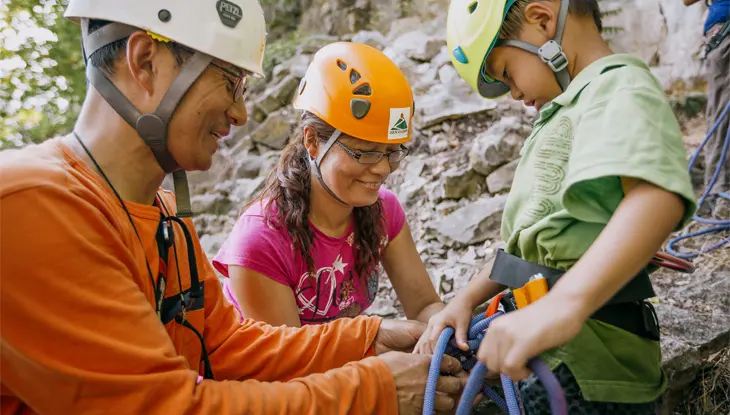Santa’s Village
Santa’s summer home in Muskoka is the perfect summer vacation destination for families in Ontario.
Santa’s Village is 24 hectares of pure fun, just minutes from Bracebridge. Its location at the curve of the Muskoka River, surrounded by thick forest and woodlands, gives the park an enchanted, fairy-tale-like atmosphere.
In addition to accommodation options, the park features theme rides, games, water attractions, animal farms and entertainment. And, of course, kids can visit with Santa and all his friends.
Every year, countless families make magical memories here at Santa’s Village.
Bracebridge | Santa’s Village
How to get to Santa’s Village
Location: 1624 Golden Beach Road, Bracebridge
By car: From Highway 11, exit on Highway 118 West. Santa’s Village is located off Santa’s Village Road, and parking is available at the entrance.
By transit: Ontario Northland provides bus service to Bracebridge. You’ll need to take a local taxi from the Bracebridge stop to Santa’s Village.
Know before you go
Santa’s Village operates seasonally. The park opens on select days in the spring and every day during the summer months. Purchase daily admission tickets or a season pass and enjoy unlimited access to rides bundled with special perks.
Strollers are available for rent on a first-come, first-served basis.
Things to do at Santa’s Village
Discover more activities and experiences.
Celebrate Christmas in the summer
Visit Santa’s friendly reindeer (plus goats, sheep and other farm animals) at the petting zoo before stopping by Santa’s house to take some photos and share your Christmas wishes.
Have fun on the rides
From the Candy Cane Express to the Go-karts and Ferris Wheel, rides and attractions at Santa’s Village bring thrills for both kids and adults.
Enjoy good food
Enjoy breakfast with Santa Claus or find baked goods at Mrs. Claus’ bakeshop, classic comfort foods at Kringle’s Kitchen, gourmet scoops at Polar Parlour Ice Cream and more great places to eat.
Attend a magical Christmas event
Santafest is a winter event that turns the village into a Christmas wonderland. View a daily tree lighting ceremony, browse the Christmas market and hear stories from Mrs. Claus.
Book on-site accommodation
Stay overnight at Santa’s Village in cozy cabins and yurts at Whispering Pines Campground, or bring your own tent or trailer.
Articles and itineraries
Get ideas and inspiration for your next trip.

Interesting facts about Santa’s Village
Santa’s Village is one of Muskoka’s oldest family-fun attractions.
In the 1950s, the newly constructed Highway 11 diverted traffic away from downtown Bracebridge. The community rallied to find a way to attract visitors back to the town.
Bracebridge is on the 45th parallel—halfway between the North Pole and the equator—so it seemed like the perfect place for Santa’s summer cottage, plus Santa-inspired attractions and a water park. Santa’s Village was built in 1955.
Accessibility features
Ramps
An inclined plane that allows wheelchair users and others to access buildings and navigate between different levels.
Wide doorways and hallways
A sufficiently wide, hard-surfaced, unobstructed path to allow for easy travel.
Automatic doors
Main entrance doors and other accessible entrances and exits are power assisted to allow easy access.
Accessible restaurant
Designed to be accessible to persons with varying disabilities, including those using mobility aids. They include an accessible entrance, adequate maneuvering space, nearby accessible washrooms, tables with removable chairs and sufficient knee clearance, menus in alternate formats, and cafeteria or buffet counters that are reachable for mobility device users.
Accessible seating
For persons using mobility aids, accessible seating is available in all areas or levels for persons using mobility aids. The path to the accessible seating should be barrier-free so a person using a mobility device can access it. Reserved space with a clear view of the event/activity for someone who is seated, good sound quality and adequate maneuvering room for a mobility device.
Accessible outdoor eating area
Places located outside where members of the public can sit at a table and eat (for example, outdoor food courts at amusement parks or picnic tables in parks). This includes accessible tables with enough clear space around and under so that people using a wheelchair or other mobility aid can easily access. Also, the ground leading to and under the accessible tables is level, firm and stable.
Information available in alternative format
Alternative formats present information beyond standard text, such as electronic text, audio, captioning and Braille. Accessible formats are available for menus, brochures, maps, signage or websites. Communication support must be provided in a timely manner upon request, at no extra charge, in consultation with the person making the request.
Wheelchair and/or mobility devices available
Mobility devices such as wheelchairs, walkers, canes or mobility scooters are available for people to borrow or rent at the business. If you make wheelchairs or assistive devices available to the public, it is important to make sure that they are properly maintained and periodically serviced so they are in good working order and do not present a safety risk.
Support persons welcome
By law, you must allow a person with a disability to be accompanied by his or her support person while in the areas of your business that are open to the public. A support person is an individual hired or chosen by a person with a disability to provide services or assistance with communication, mobility, personal care, medical needs or with accessing goods, services or facilities. If you charge an admission fee at your business, you must let people know you charge an additional fee for a support person.
Service animals welcome
Can be identified by visual indicators (such as a vest or harness) or documentation from a regulated health professional confirming the animal is necessary due to a disability. In Ontario, service animals are allowed in all public spaces unless otherwise prohibited by law. A service animal is not a pet; it is trained to perform tasks to assist a person with a disability, such as guiding individuals with vision impairments, alerting to sounds for those with hearing impairments, assisting during seizures, retrieving items, or helping manage psychiatric and neurological disabilities. There are no restrictions on the type of animal used as a service animal in Ontario. If the animal is not easily identifiable, the person can provide documentation from a regulated health professional confirming the need for the service animal.
Accessible parking space
Accessible parking provides a place for people with disabilities to park and space to get in and out of their vehicles safely. It also provides access to the main accessible entrance and/or any other accessible entrances. Most users of wheelchairs need at least three feet of clearance to get in and out of their vehicles.
Accessible drop off location
A designated and signed area used for loading and unloading passengers into or out of a waiting vehicle. A passenger drop-off/pick-up area typically should include a driveway, a lay-by for the stopped vehicle close to an accessible entrance and an accessible route from the drop-off/pick-up area to the main entrance. It is important that any drop-off locations are clear of snow and ice or other obstructions.
Accessible washroom
At least one washroom stall larger than the others to accommodate adequate maneuvering space for mobility devices. They also include grab bars, transfer space, an accessible door latch, sink with knee clearance, and lever handles or automatic sensor faucets.
Universal washroom
A separate washroom that allows an individual in a wheelchair to use a self-contained washroom facility. They include grab bars, transfer space, an accessible door handle/lock, accessible sink with knee clearance, easy-to-use/automatic faucets, adult change table and emergency call systems. It is also universal, allowing people of any gender to use it comfortably, including with a support person if needed.
Emergency communication systems
Providing alerts and information in multiple formats including text-based alerts, audio messages and visual cues.
Accessible campsites
Sites should be level with adjacent grades and have a firm, well-draining surface and include adjacent accessible parking. Picnic tables and barbecue pits should be in close proximity to the campsite and wheelchair accessible. A firm surface, roadway or path should also connect the accessible campsite to key amenities, such as accessible washrooms, showers, and other campground amenities.
Last updated: September 2, 2025








